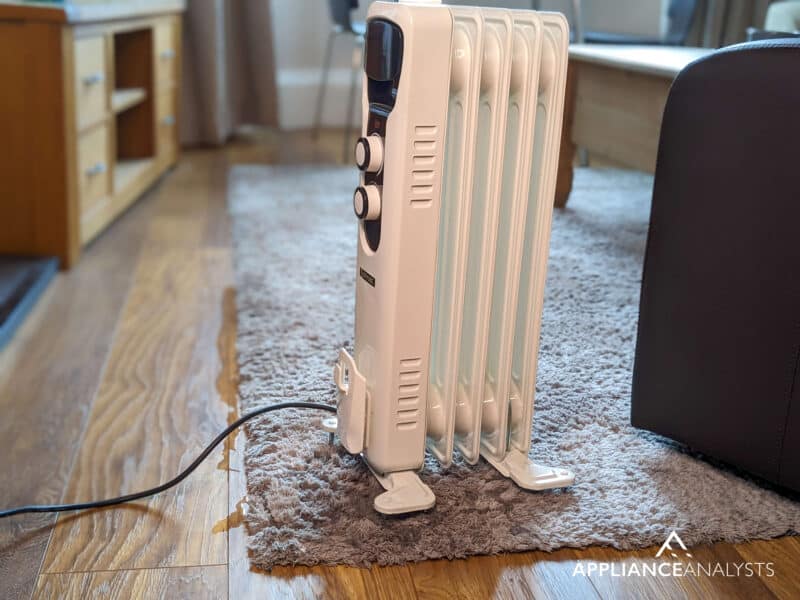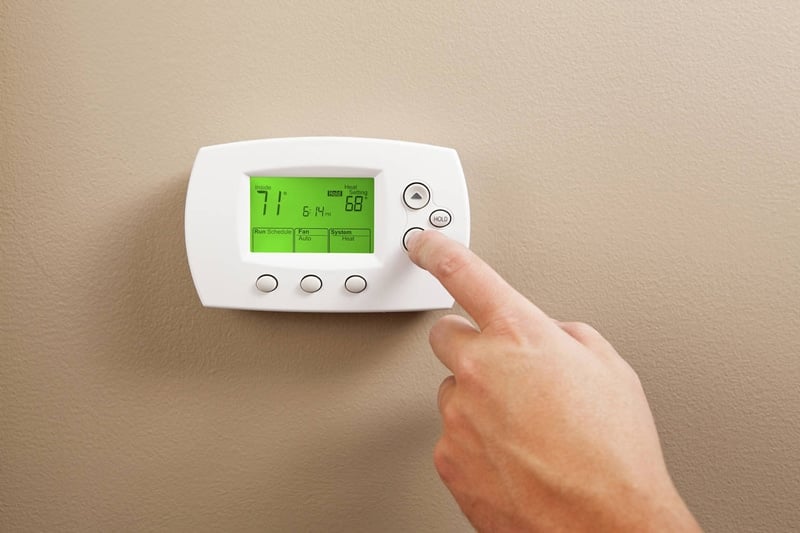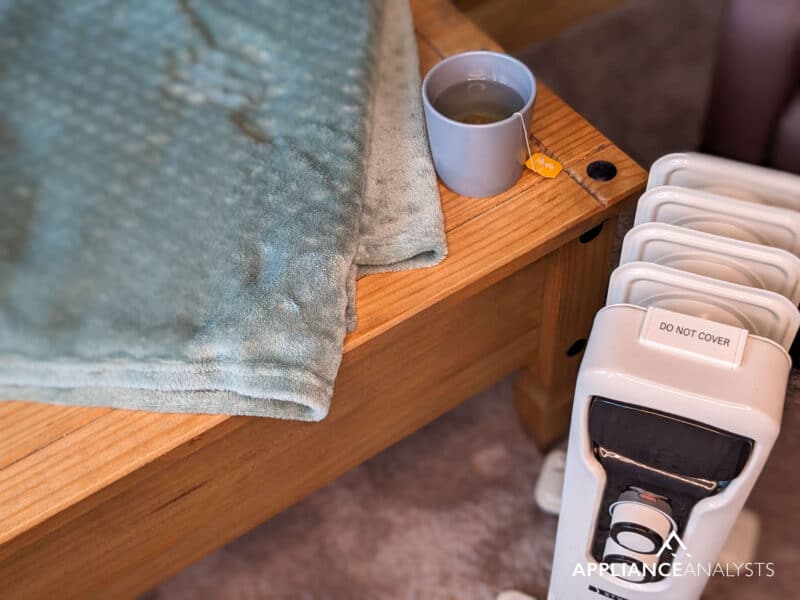We've independently reviewed this article to make sure it's as accurate as we can make it.
To find out more about our article creation and review process, check out our editorial guidelines.
Is your oil-filled radiator not working?
Sadly, I’ve been there too. There’s nothing more annoying than not being able to use your oil-filled radiator, especially when you’ve paid a hefty amount of money for it.
But, don’t worry. You’ve come to the right place for answers.
If your oil-filled radiator isn’t working, please check the power cord and turn the thermostat up. You can also try removing any obstructions or bleeding the radiator to solve the issue.
Keep reading to learn how to get your oil-filled radiator working again!
4 Ways to Fix Your Oil-Filled Radiator
Is your portable oil heater not turning on? Before you call it a day and start digging out your heaviest duvet and fluffy slippers, there’s still something you can do.
In this article, you will find 4 ways of fixing your oil-filled radiator. These steps will explain the problems that arise with these units and what you can do to fix them. Check it out.
#1 Check the Power Cord
If your oil-filled radiator isn’t working or turning on, you should first ensure that it is getting power. This means inspecting the power cord.

But what exactly are you looking for? Here’s a mini checklist for you to go through to eliminate a power cord problem:
- Check that the power cord is plugged in properly. Ensure the power cord is firmly in the electrical outlet.
- Examine the status of the power cord. It should not show any signs of damage or wear and tear. If you see any fraying, bite marks, or discoloration of the plug and wall socket, discontinue its use. Replace the power cord before continuing.
- Plug the power cord into a different electrical outlet. If the radiator begins to work in another outlet, you may need to call an electrician.
- Unplug the power cord from an extension cord. You should connect the plug directly to a wall outlet. An extension cord will not be able to handle a device this powerful.
- Unplug other electrical items from the circuit. Do not overload the circuit.
After thoroughly checking your power cord with the help of these steps, it should work again. But if it doesn’t, move on to the next set of troubleshooting tips.
#2 Turn the Thermostat Up
The next way to fix your oil-filled radiator is to check the thermostat’s settings.
Your radiator should turn on when your house reaches a certain temperature. If this temperature is set too low, then the radiator will not turn on until it is very cold in the house.
What can you do to fix this problem? It’s simple. Start by turning the thermostat up 5 degrees. After that, you should feel the heater beginning to work. If it doesn’t, turn it up a further 5 degrees and see if it heats up.

If the radiator heats up when set to a higher temperature, simply change these settings for the next time.
Adjust the thermostat so that it will kick in at a temperature that is comfortable for you. Most energy companies will recommend you set it between 70 and 78 degrees Fahrenheit.
#3 Remove Any Obstructions
If your oil-filled heater isn’t heating up the room or turning on, you might want to keep reading.
There are a couple of reasons why this happens that have to do with obstructions and covers on the radiator.

Your radiator should be free from any obstructions and covers at all times. Go through the following checklist to find out what you should do:
- Remove anything that is covering the radiator. Some of the newest oil-filled radiators come with an automatic shut-off feature. This feature turns the radiator off as soon as it detects something covering it that could be a fire hazard. Here’s an action plan for your radiator:
- If your radiator is covered by something, remove it
- Allow the radiator time to cool down before you plug it back in. This will deactivate the automatic shut-off feature.
- Avoid plugging the radiator next to curtains or tablecloths.
- Remove any obstructions from the radiator’s inlet and outlet. Some of the newest oil-filled radiators come with an automatic shut-off feature. This feature turns the radiator off as soon as it detects an obstruction that could be a fire hazard. Here’s an action plan for your radiator:
- If your radiator’s inlet or outlet has an obstruction, remove it.
- Allow the radiator time to cool down before you plug it back in. This will deactivate the automatic shut-off feature.
- Avoid plugging the radiator near fabrics or sandwiching it between items of furniture. It should be at least 3 feet or 90 cm from any other item at all times. Avoid contact with the front, sides, and back of the appliance with any other item.
#4 Bleed the Radiator
When was the last time you bled your oil-filled radiator? If you can’t remember when you last bled it or doubt you ever have, then there’s no time like the present!
If your oil heater is not working properly, this could be a sign that it needs bleeding. You should do this job periodically to keep the radiator in tip-top condition.

But how can you go about bleeding a radiator? Here are all the steps and tools that you’ll need for this job.
Please bear in mind that you’ll need a mug and a radiator key or a screwdriver.
- Place a mug underneath the radiator, directly under the valve.
- Use the radiator key or screwdriver to turn the valve anticlockwise.
- Turn the valve to release the air. Turn it until water begins to drip out.
- Tighten the valve back up again.
How to Keep Your Oil-Filled Radiator In Good Order
Oil-filled radiators are a lifeline for any garage, storage room, or office with no heating.
If you have a brand-new heater, follow these quick tips to keep it as good as new:
- Keep the radiator at least 90 cm or 3 feet away from any other item.
- Always disconnect the radiator when you are not using it.
- Do not use the appliance outdoors nor in bathrooms or similar rooms.
- Do not run the power cord under carpeting.
- Keep the appliance away from water.
- Wait for the appliance to cool down before you store it and wrap the power cord around it.
Wrapping Up: Fixing Your Oil-Filled Radiator
Oil-filled radiators are the perfect solution for warming up offices, lofts, and basements. But what should you do if your oil-filled radiator isn’t working? Spending the weekend sitting in the cold is a miserable option, and throwing the radiator into the skip isn’t much better.
Thankfully, this article has listed 4 things you can do to fix your oil-filled heater. I’m sure these suggestions have helped you to see why your heater is acting up and what you can do to get it working again.
Has this article been helpful to you? Then make sure you check out our other articles and free guides on our website. You could even sign up to our email list.
Have a great day!
-Craig







